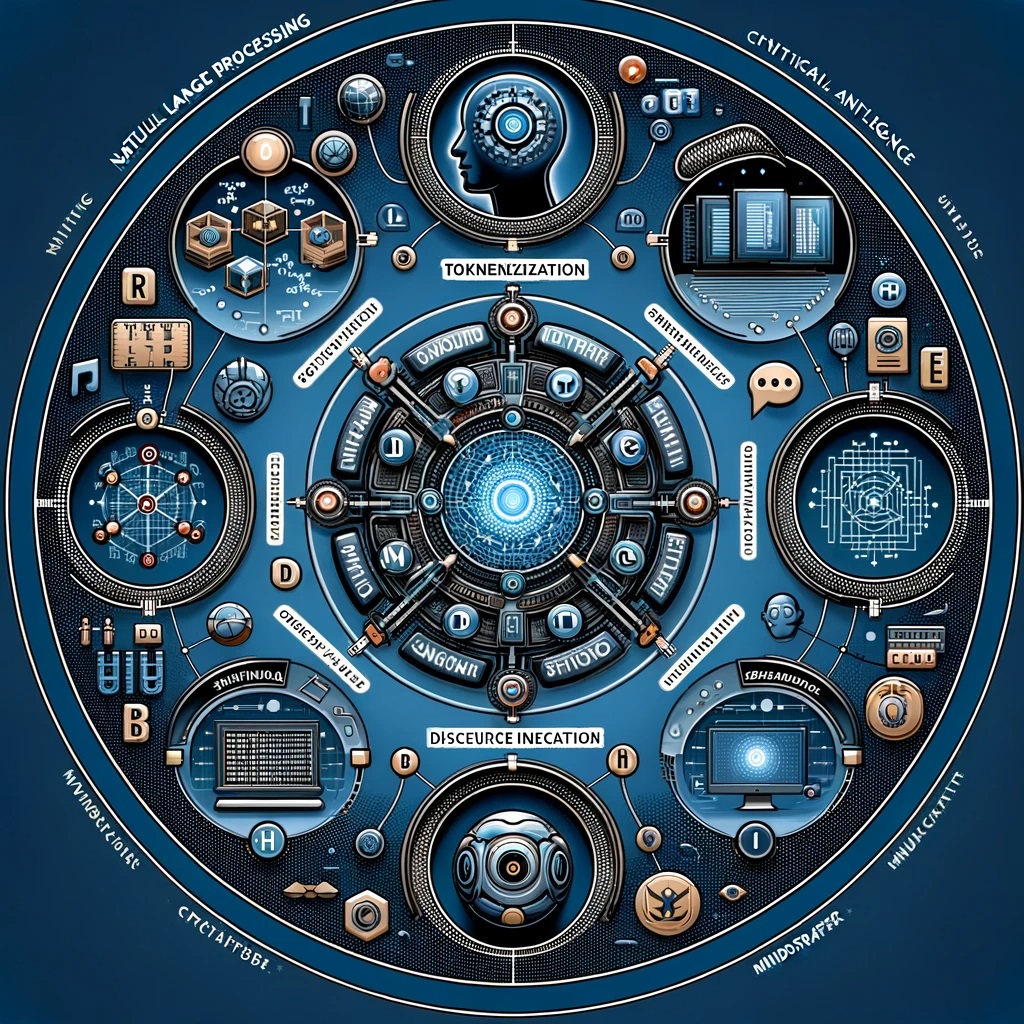
AI and Natural Language Processing NLP
How AI and Natural Language Processing are Revolutionizing the Way We Communicate:
Artificial Intelligence and Natural Language Processing have become the talk of the tech industry and for a good reason. Not only are these technologies advancing rapidly, but they are also reshaping how we communicate with each other and with machines. Thanks to AI and NLP, engines now have the ability to understand and interpret human language, resulting in more efficient and personalized communication. In fact, these technologies, including chatbots, voice assistants, and language translation, are making global communication smoother and more seamless. Moreover, integrating AI and NLP creates new opportunities in healthcare, finance, and education. As we continue to push the boundaries of these technologies, we can expect even more significant impacts on our interactions with the world. This article will explore how AI and NLP are revolutionizing communication and discuss the implications for businesses and society.
Understanding Natural Language Processing (NLP):
Natural Language Processing is a branch of Artificial Intelligence focusing on the interaction between computers and humans using natural language. NLP involves the processing and analysis of natural language data, including speech and text, to produce valuable insights and actions. NLP algorithms use machine learning and deep learning techniques to understand the nuances of human language, including syntax, semantics, and context. The goal of NLP is to enable machines to understand, interpret, and generate human language in a natural and intuitive way.
Altogether, one of the primary challenges in NLP is dealing with the ambiguity and variability of human language. Words and phrases can have different meanings depending on the context in which they are used. People often use idioms, sarcasm, and other nuances that are difficult for machines to understand. To overcome these challenges, NLP algorithms use statistical models and machine learning techniques to learn from large amounts of language data. Moreover, these models also identifies the patterns and relationships in language and make predictions about future language use. Moreover, NLP has many applications, from speech recognition and language translation to sentiment analysis and chatbots.
The Role of AI in NLP:
Artificial Intelligence plays a crucial role in NLP by providing the computational power and algorithms necessary for machines to understand and interpret human language. AI algorithms use statistical models and machine learning techniques to analyze large amounts of natural language data and identify patterns and relationships. Researchers can train these models to recognize speech, translate languages, and generate human-like responses to text and speech inputs.
In addition, one of the key benefits of AI in NLP is the ability to personalize communication. With AI-powered chatbots and voice assistants, machines can understand individual preferences and tailor responses to meet the needs of each user. AI algorithms can analyze language data to identify patterns in user behaviour and adapt to personal preferences over time. This enables machines to provide more personalized and engaging communication tailored to each user’s needs.
It is worth mentioning that AI in NLP is also revolutionizing the way we interact with machines. Voice assistants like Siri and Alexa enable users to interact with machines using natural language, making communication more intuitive and natural. AI algorithms can understand spoken language and generate appropriate responses, making it easier for users to navigate complex tasks and access information.
Applications of AI and NLP in daily life:
AI and NLP are already having a significant impact on the way we communicate in our daily lives. In this case, These technologies, from voice assistants to chatbots, are making communication more efficient, personalized, and accessible. Here are some of the most common applications of AI and NLP in daily life:
Voice assistants
Voice assistants like Siri, Alexa, and Google Assistant use AI and NLP to understand natural language and provide personalized responses to users. In this case, these assistants can perform various tasks, from setting reminders , making phone calls, ordering groceries, and controlling smart home devices. Voice assistants are becoming increasingly sophisticated, with some even able to hold natural-sounding conversations with users.
Chatbots
AI-powered virtual assistants known as chatbots enable businesses to provide 24/7 customer support and engage with customers in real time. Businesses can program chatbots to answer common questions, provide product recommendations, and even process orders. They use NLP to understand the intent behind customer inquiries and generate appropriate responses.
Language Translation
AI-powered language translation tools like Google Translate use NLP to analyze natural language and generate accurate translations in real time. In this case, these tools enable people to communicate with others who speak different languages, breaking down language barriers and enabling seamless global communication.
Sentiment analysis
AI-powered sentiment analysis tools use NLP to analyze social media posts, online reviews, and other forms of user-generated content to determine the sentiment behind the language. This enables businesses to understand the opinions and attitudes of their customers and identify areas for improvement.
AI and NLP in business communication:
AI and NLP are transforming the way businesses communicate with customers and each other. In this case, these technologies enable businesses to provide more personalized and engaging communication tailored to individual customers’ needs. Here are some of the ways AI and NLP are being used in business communication:
Customer service
AI-powered chatbots are becoming increasingly common in customer service, enabling businesses to provide 24/7 support and engage with customers in real time. Chatbots can answer common questions, provide product recommendations, and even process orders, freeing up human agents to focus on more complex tasks.
Language Translation
Businesses are using AI-powered language translation tools to break down language barriers and enable more seamless communication between international teams and customers. In this case, these tools can translate emails, documents, and other forms of written communication in real time, making it easier for businesses to operate globally.
Sentiment analysis
AI-powered sentiment analysis tools are being used in business communication to understand the opinions and attitudes of customers. By analyzing social media posts, online reviews, and other forms of user-generated content, businesses can identify areas for improvement and make data-driven decisions to improve customer satisfaction.
AI and NLP in healthcare communication:
AI and NLP are also transforming the way we communicate in healthcare. These technologies enable healthcare providers to provide patients with more personalized and efficient care, improving outcomes and reducing costs. Here are some of the ways AI and NLP are being used in healthcare communication:
Electronic health records
AI-powered electronic health records enable healthcare providers to store and access patient information more efficiently. In this case, healthcare providers can analyze these records using NLP to identify patterns and relationships in patient data, enabling them to make more informed decisions about patient care.
Medical imaging
AI-powered medical imaging tools use NLP to analyze medical images and identify patterns and anomalies. This enables healthcare providers to make more accurate diagnoses and develop more effective treatment plans.
Natural language processing for patient communication
AI-powered NLP tools are being used in patient communication to improve patient engagement and outcomes. NLP algorithms can analyze patient language to identify symptoms and provide appropriate recommendations for care. This enables healthcare providers to offer more personalized and efficient care to patients.
AI and NLP in social media communication:
Artificial Intelligence and Natural Language Processing are also transforming the way we communicate on social media. Here are some of the ways AI and NLP are being used in social media communication:
Sentiment analysis
AI-powered sentiment analysis tools are being used on social media to understand the opinions and attitudes of users. By analyzing social media posts, businesses can gain insights into customer preferences and identify areas for improvement.
Content curation
AI-powered content curation tools use NLP to analyze user behaviour and provide personalized content recommendations. In this case, these tools can analyze user preferences and behavior to provide relevant and engaging content to each user.
Chatbots
AI-powered chatbots are being used on social media to engage with users in real time. Chatbots can answer common questions, provide recommendations, and even process orders, providing a more seamless and efficient user experience.
Future of AI and NLP in communication:
As AI and Natural Language Processing technology continue to evolve, we can expect to see even more significant advancements in communication. Here are some of the trends we can expect to see in the coming years:
More personalized communication
As AI algorithms become more sophisticated, we can expect to see even more personalized communication tailored to individual users’ needs. Voice assistants and chatbots will be able to understand personal preferences and behaviour, providing more relevant and engaging communication.
Improved language translation
As Natural Language Processing algorithms become more sophisticated, we can expect to see even more accurate and natural-sounding language translation. This will enable more seamless global communication, breaking down language barriers and enabling more efficient international communication.
More advanced sentiment analysis
As AI algorithms become more sophisticated, we can expect to see even more advanced sentiment analysis that can more accurately analyze language data to identify emotions and attitudes. This will enable businesses to gain deeper insights into customer preferences and behaviour and make more informed decisions.
Ethical Considerations in AI and NLP Communication:
As AI and Natural Language Processing technology continues to evolve, it is essential to consider the ethical implications of these technologies. One of the primary concerns is the potential for bias in AI algorithms, which can lead to discrimination and unfair treatment. It is crucial to ensure that AI algorithms are developed and trained ethically and unbiasedly, considering the potential for unintended consequences.
Another concern is the potential for AI to replace human communication entirely, leading to a loss of empathy and human connection. While AI and NLP can provide more efficient and personalized touch, it is essential to ensure that these technologies are used to complement human communication rather than replacing it entirely.
Conclusion:
Lastly, AI and Natural Language Processing are revolutionizing how we communicate with each other and machines, providing more efficient, personalized, and engaging communication than ever before. From chatbots and voice assistants to language translation and sentiment analysis, these technologies transform how we interact with the world around us. As we continue to push the boundaries of AI and NLP, we can expect to see even more significant advancements in how we communicate, with far-reaching implications for businesses and society. However, it is essential to consider the ethical implications of these technologies and ensure that they are developed and used in a way that promotes fairness, empathy, and human connection.
NLP Basics for Beginners, watch complete video for understanding the basics of NLP.

Shabbir
Pingback: ai in data science
Pingback: neural network in artificial intelligence
Pingback: AI for Pattern Recognition
Pingback: AI and Blockchain